Fish with big eyes make up around 18 species of aquatic creatures in the Priacanthida family. Not only are these fish irresistibly cute to look at, but their unique feature equips them for many challenges they face in underwater habitats. Therefore, setting them apart from other Vertebrata by exhibiting them as extraordinary. Did you know that fish with big eyes can enhance vision in low-light conditions and detect predators and prey from a distance? Also, they have the ability to adjust their eyes for depth perception, which assists them in navigating and steering clear of any underwater obstacles. Remarkable, isn’t it? So, let us delve deep into the waters of fish that have big eyes and discover which big-eyed fish is best suited for your tank.
1. Telescope Goldfish (Carassius auratus)
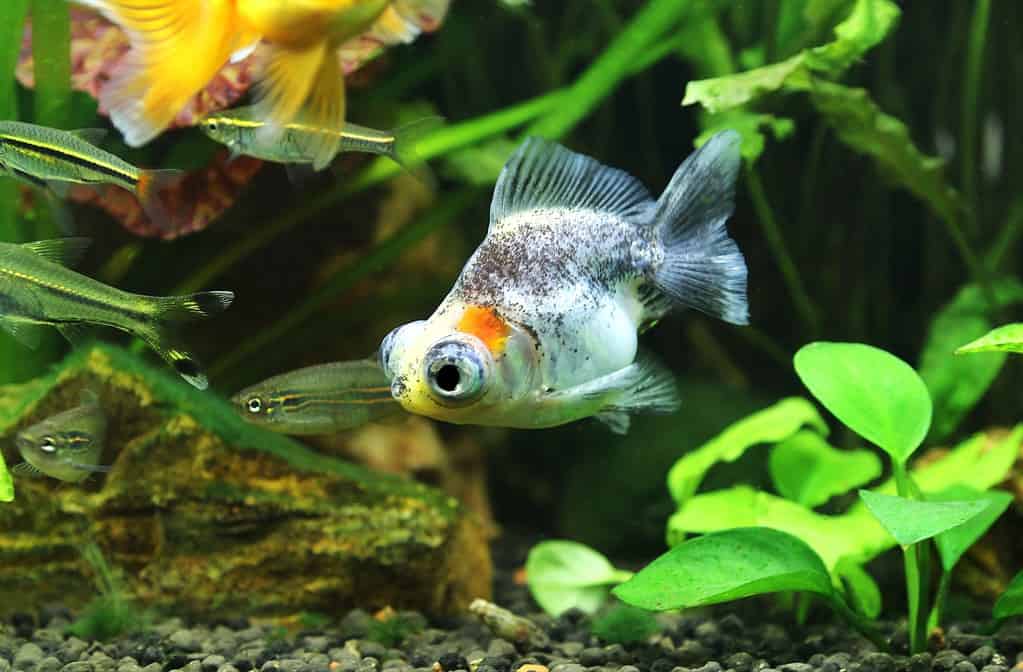
Telescope eye goldfish is one of the most popular ornamental fish.
©Arunee Rodloy/Shutterstock.com
The Telescope Goldfish is characterized by its protruding eyes and elegant flowing fins. These fish have gained popularity among the aquarium community, where their eyes take center stage, becoming the stargazers of the underwater world.
Even though their large eyes may appear to give them clear eyesight, this is, in fact, the opposite of what the telescope goldfish experiences. Due to the unfortunate placement of each eye, they actually have very poor eyesight.
Furthermore, when feeding your telescope goldfish, rather feed it sinking pellets and place them in the same spot for every feed. Consequently, training your fish to recognize where to locate its food gives it time to eat without competing for a meal.
2. Horse-eye Jack (Caranx latus)
Horse-eye Jack is a large-eyed freshwater fish from the Atlantic Ocean. Its big reflective eyes are put to use when on the lookout for prey, especially when swimming in cloudy waters. Because they hang about in shallow water, they can make a quick escape if dangerous predators approach.
Horse-Eye Jacks are known for their strength and strong swimming. Having streamlined bodies allows them to move swiftly through the water. As a result, these game fish are highly sought after by fishing enthusiasts who look forward to a challenging catch.
3. Barracuda (Sphyraena spp.)
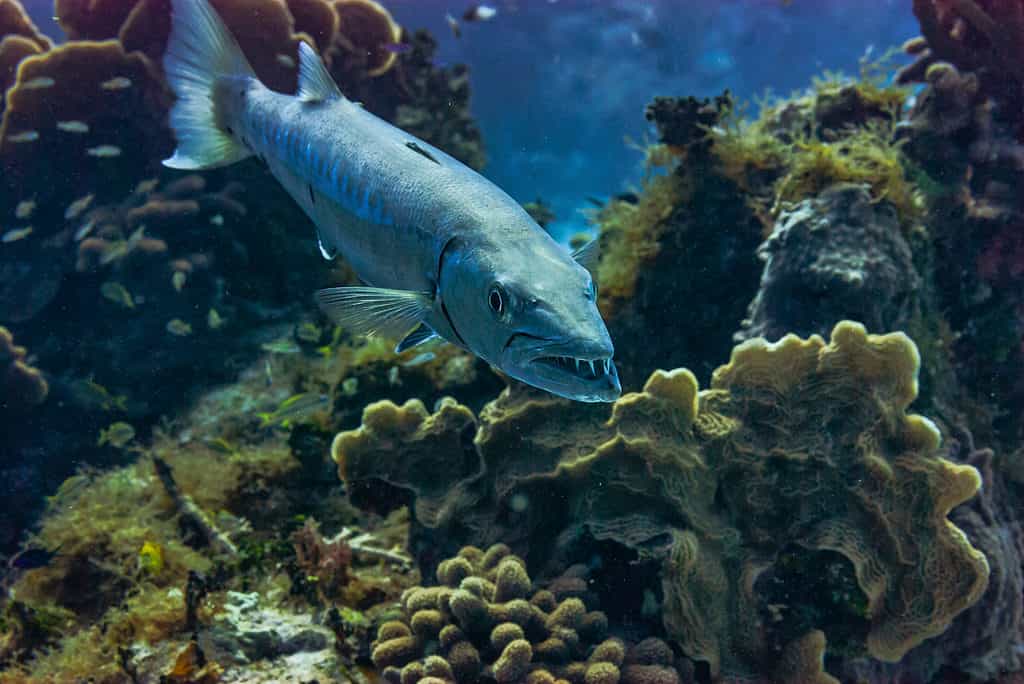
Great
barracuda
can reach over 100 pounds and approximately 4-6 feet in length.
©Focused Adventures/Shutterstock.com
The Barracuda is classified as an ambush hunter, where it uses its sharp teeth to catch small reef fish, squid, and crustaceans. While concealing itself among seagrass beds and coral reefs, they use their big eyes to target and chase down their prey with remarkable accuracy. In addition, Barracuda fish surround subtropical and tropical waters and reach lengths of approximately 4-6 feet in length.
4. Blue Shark (Prionace glauca)
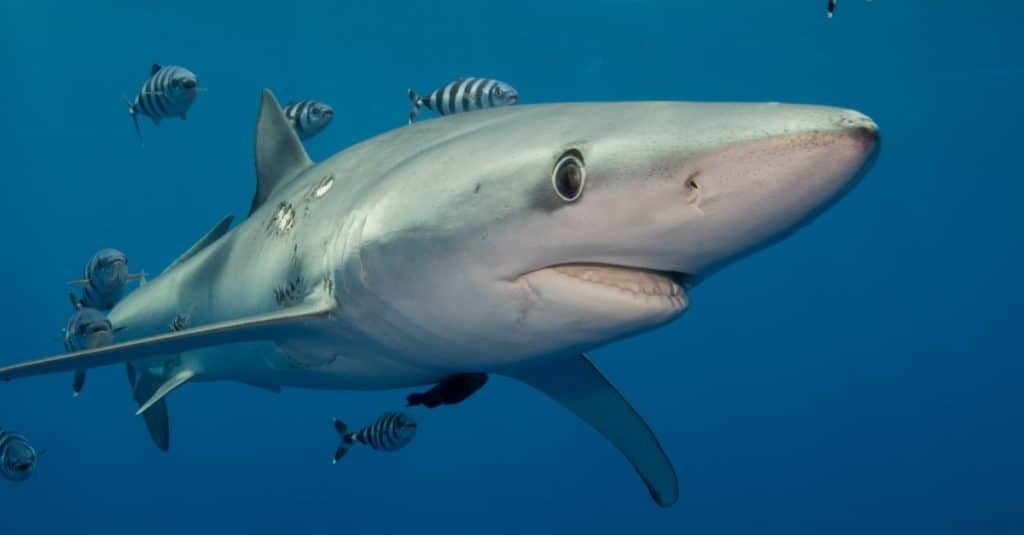
A
Blue shark
use their big eyes and sensory perception to feed on vulnerable fish.
©Jan Finsterbusch/Shutterstock.com
Blue sharks feature a slender shaped body and counter-shade skin coloring. In particular, its upper body displays a deep indigo-blue hue and fades to a lighter blue on its sides. During the summer months, blue sharks tend to migrate where they are in search of cooler waters.
As blue sharks roam the deep depths of the dark oceans, they use their big eyes and sensory perception to feed on vulnerable fish species. In addition, their diet consists of squid, turtles, and schooling fish.
5. Tarpon (Megalops atlanticus)
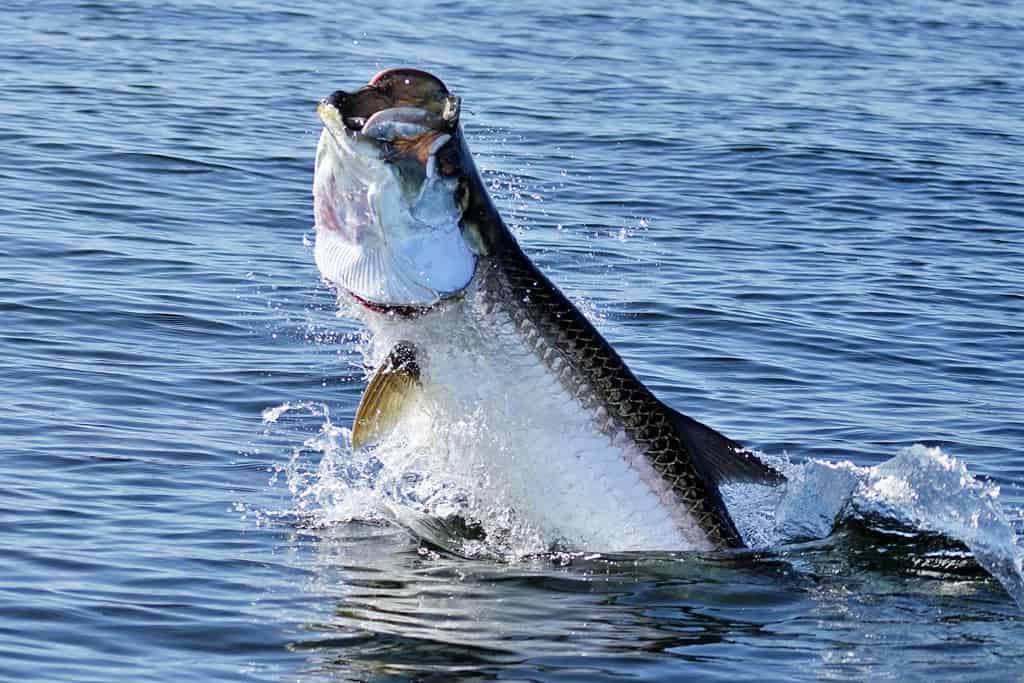
Its species uses its oversized eyes for UV vision to detect prey and predators that have reflective skins.
©Daniel Smith/ via Getty Images
Tarpon fish swim in the coastal waters of Florida, the Caribbean, and the Gulf of Mexico. These silvery fish are truly exceptional as they utilize an interesting technique called air-breathing. When tarpon jump out of the water, they gulp a mouth full of air, which is used to extract oxygen. As a result, they may continue to breathe underwater.
Apart from this, Tarpon fish will use its oversized eyes for UV vision to detect prey and predators that have reflective skins.
6. Squirrel Fish (Holocentridae)
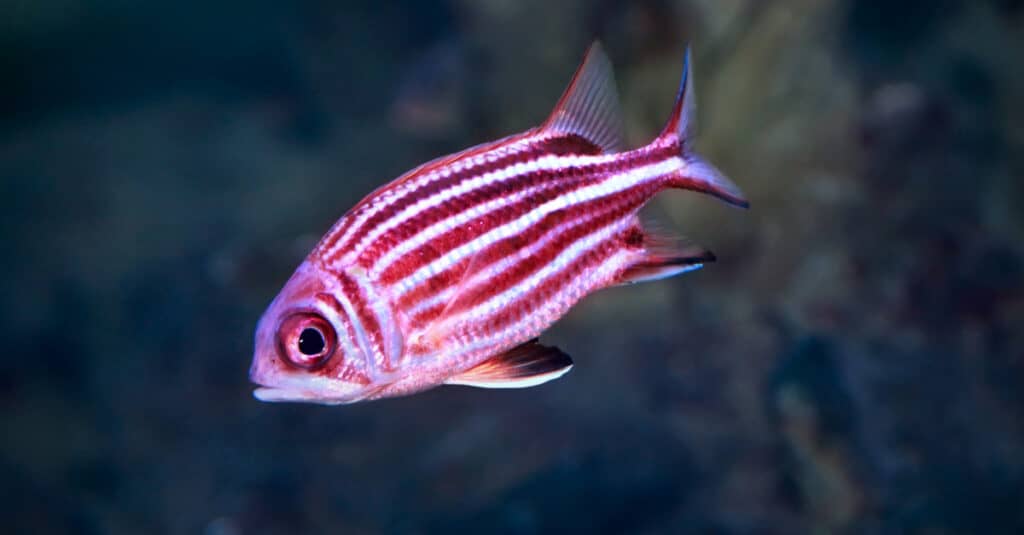
Squirrelfish eyes serve as a great advantage when searching for food in the dark.
©Tatiana Belova/Shutterstock.com
Squirrel fish have two pairs of eyes, its first pair is used to observe the world above water, while the second views the bottom of the ocean. Also, its prominent eyes serve as a great advantage when searching for food in the dark. Being nocturnal hunters, they can blend seemingly into dark ocean bottoms and catch their prey off guard.
Squirrel fish prefer to camouflage themselves among the coral reefs during the day. When exploring at night, they enjoy feeding on zooplankton, crustaceans, and gastropods.
7. Bigeye Fish (Priacanthida)
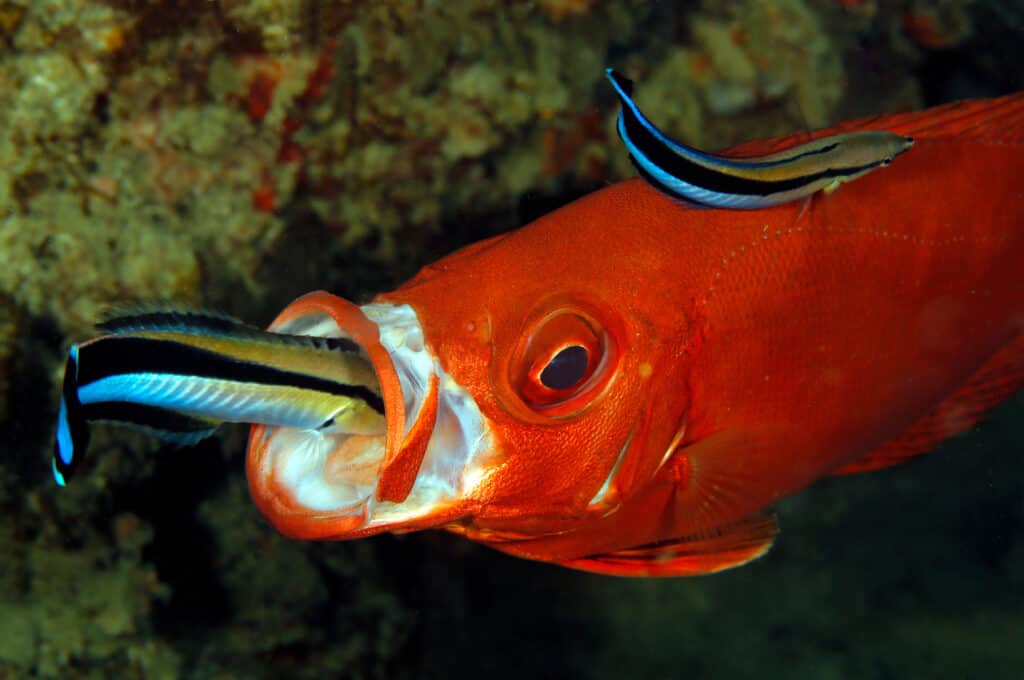
Bigeye fish display an orange-red coloring and oval shaped body.
©Daniel Lamborn/Shutterstock.com
The priacanthid family includes about 50 species of deepwater fishes, which are found throughout the Atlantic. Pacific and Indian Oceans. These ray-finned fish display an orange-red coloring and oval shaped body. In addition, the bigeye inhabits depths of 650 feet, where their spectacular saucer eyes give them an advantage to see clearly for their nocturnal habits.
8. Swordfish (Xiphias gladius)
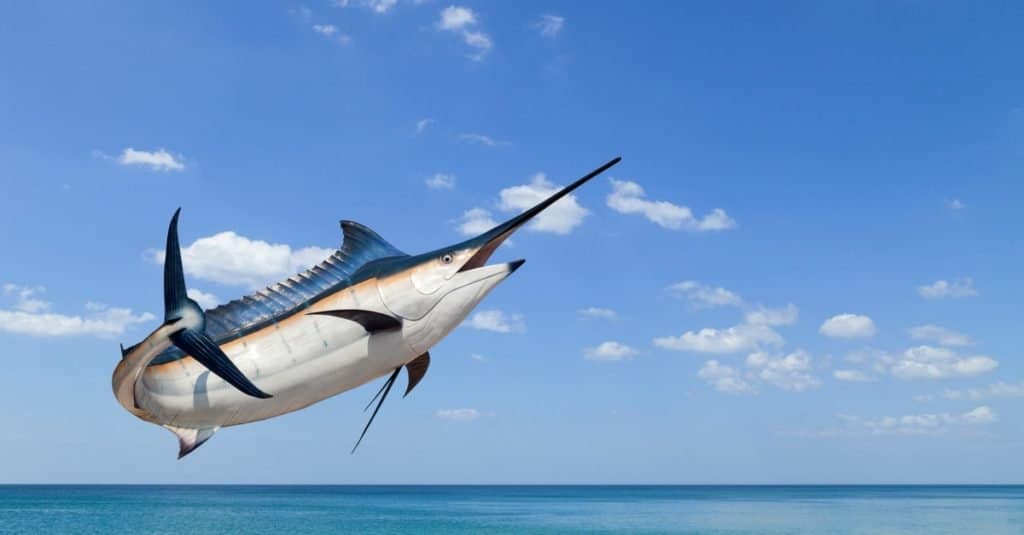
These fish reach substantial sizes, where some exceed 15 feet in length and weigh over 1,400 pounds.
©Stock High angle view/Shutterstock.com
Swordfish are majestic creatures that are known for their long, sharp snouts. Its species have the potential to reach substantial sizes, where some exceed 15 feet in length and weigh over 1,400 pounds. Apart from their size, swordfish swim at record-breaking speeds of 30 miles per hour.
Additionally, its big eyes are surrounded by muscles that assist in maintaining warmth and flashes of movement efficiently when their eye temperature is elevated.
9. Spotted Ratfish (Hydrolagus colliei)
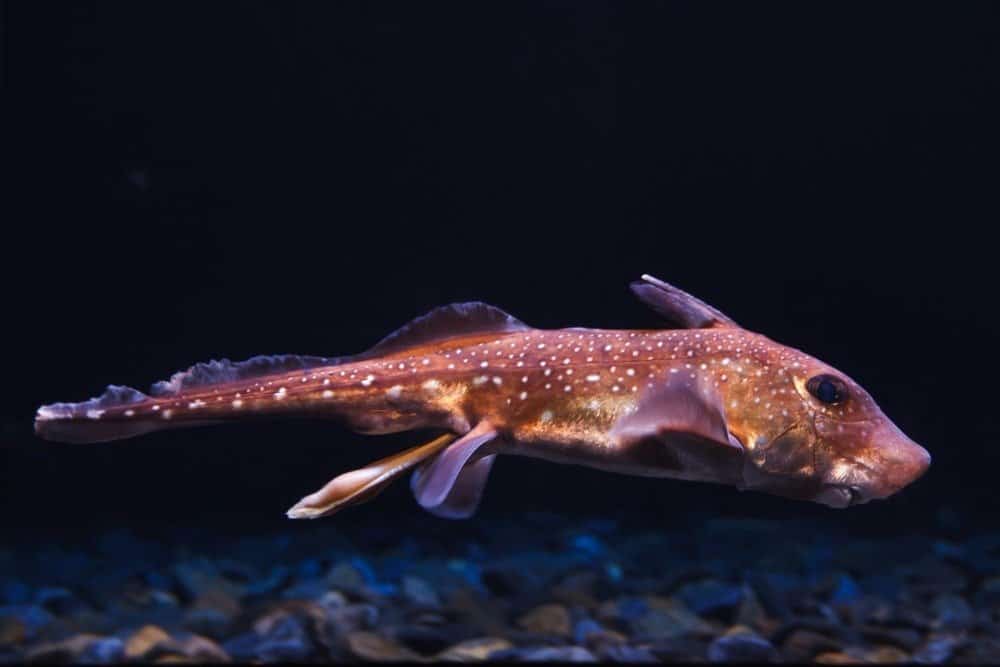
Spotted ratfish are equipped with a venomous spine situated in front of its dorsal fin.
©Vladimir Wrangel/Shutterstock.com
The Spotted Ratfish is a cute cartilaginous fish that dwells around southeast Alaska to Baja and the northern Gulf of California. Its species have a distinctive elongated tail, which resembles a rat’s tail. This explains why they were named the spotted ratfish.
Furthermore, spotted ratfish are equipped with a venomous spine which is situated in front of the dorsal fin. If they sense any danger or feel threatened, they will defend themselves by inflicting a painful sting.
10. Thresher Shark (Alopias vulpinus)

Thrasher sharks tail fin glides through strong water currents and strikes prey when feeling hungry.
©Shane Gross/Shutterstock.com
Thresher sharks parade an incredible caudal fin, which can be nearly as long as the rest of its body. Its tail fin is used for easy gliding through strong water currents and strikes prey when feeling hungry. In addition, these fish devour many prey, which include sardines, squid, and mackerel.
Even though thresher sharks are intimidating creatures, they still attract the attention of sport and commercial fishermen. Its large size and challenging fight make them sought-after game fish.
11.Celestial Eye (Carassius auratus)
The Celestial Eye Fish has gained quite a reputation for its peculiar-looking eyes. Interestingly, these fish’s big eyes can grow up to three times larger compared to their family fish relatives. Moreover, their eye lens focuses light onto the retina at the back of the eyeball, which adds to excellent eyesight.
Celestial Eye fish thrive off a well-balanced diet, which includes brine shrimp, blood worms, daphnia, and either pellet or flake fish food.
12. Lemonpeel Angelfish (Centropyge flavissima)
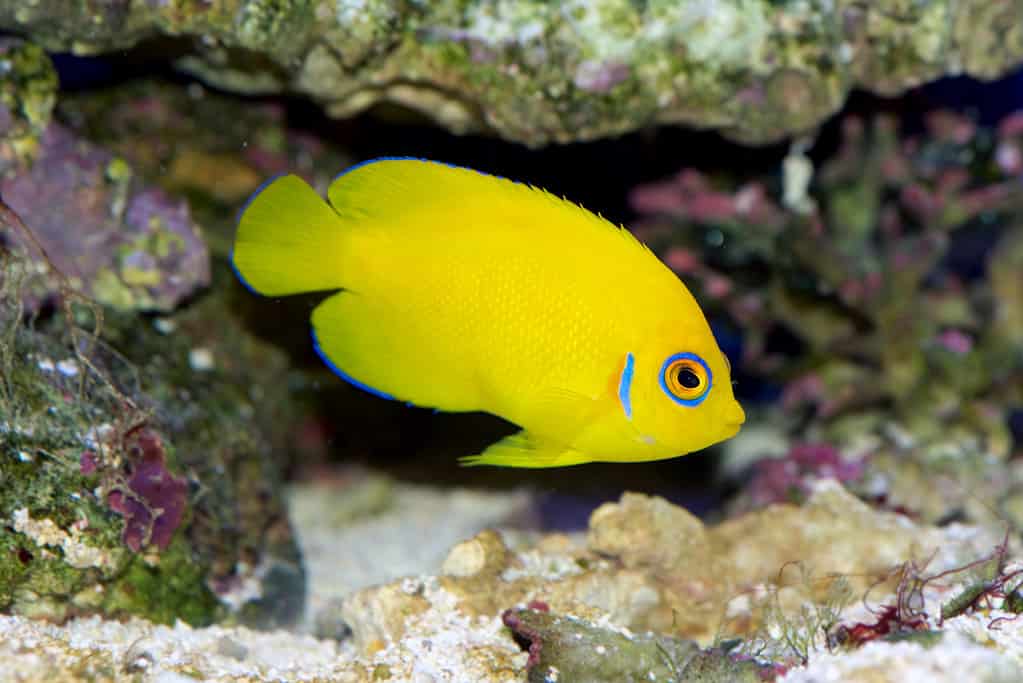
These tropical fish live among coral reefs feeding on algae and small invertebrates.
©PAUL ATKINSON/Shutterstock.com
Lemonpeel angelfish displays striking bright yellow scales and big eyes. These angelfish are indigenous to the tropical Indo-Pacific and marine aquariums around the world. In the wild, Lemonpeel angelfish live among coral reefs feeding on algae and small invertebrates. As for aquarium settings, they control algae growth, making them valuable additions to marine tanks.
Lemonpeel Angelfish are usually peaceful fish. However, there may be times when they exhibit hostile behavior, particularly in smaller tanks.
13. Bigeye Tuna (Thunnus obesus)
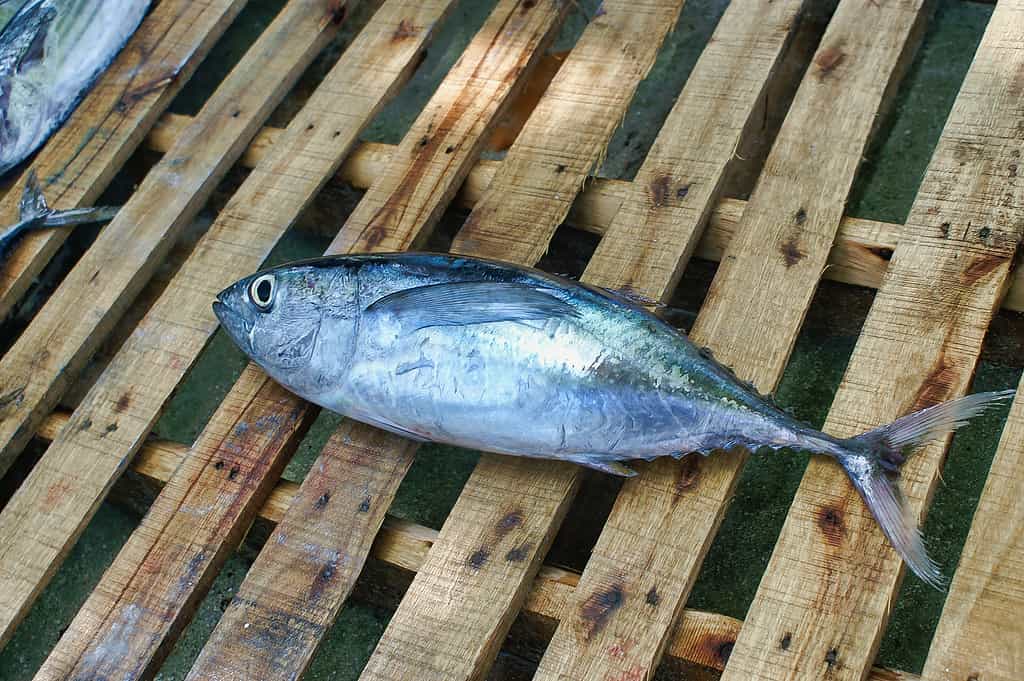
Its big eyes consist of spherical lenses, which function well in dim environments.
©MikeCloudStock/Shutterstock.com
Bigeye tuna are large fish that feature a slender torpedo body shape. They also have elongated dorsal and anal fins to keep them balanced while swimming. These tuna usually grow approximately 6- 8 feet long and weigh in hefty weights of 150-400 pounds.
Because they prefer cooler water, you will find bigeye tuna exploring depths of 150-800 feet. Moreover, its big eyes consist of spherical lenses, which function well in dim environments.
14. Dwarf Pufferfish (Carinotetraodon travancoricus)
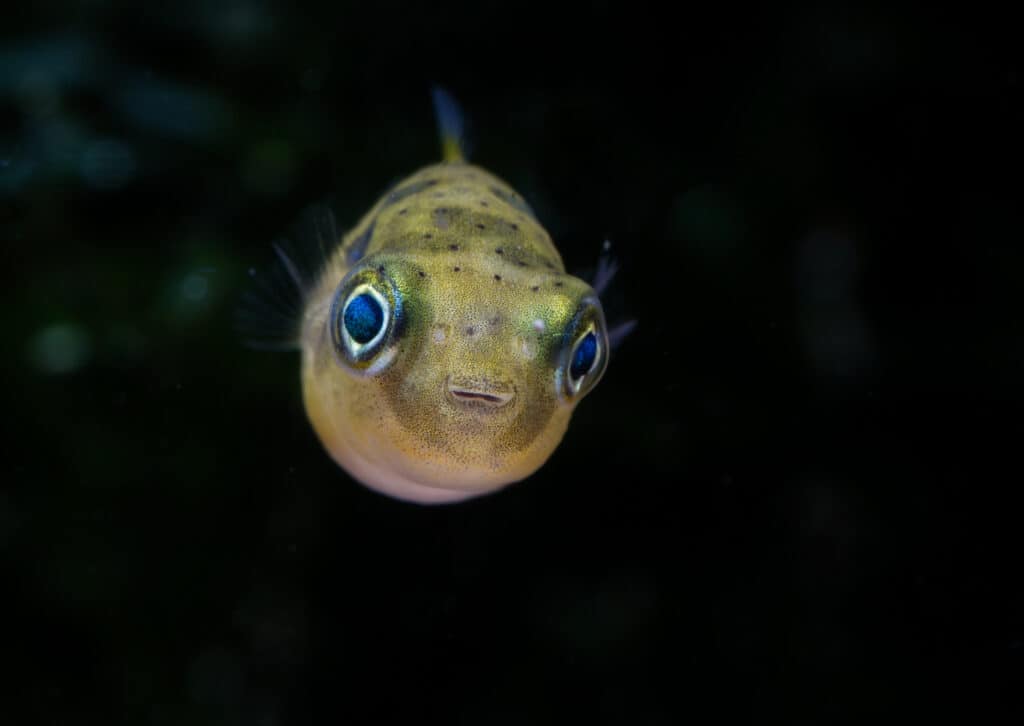
Pea puffers generally reach a length of 1-inch long.
©Toxotes Hun-Gabor Horvath/Shutterstock.com
Dwarf puffer fish showcase iridescent scales of green, brown, and yellow patterns. Their inquisitive nature adds to their charm as they actively explore their surroundings. These puffers may be small but may act on territorial behavior, especially towards their own kind.
Further, dwarf puffers possess sharp beak-like teeth that have adapted for crushing shells of small invertebrates and snails.
Tankmates that’s Best Suited for Big Eye Fish
- Flame Angelfish
- Coral Beauty Angelfish
- Firefish gobies
- Neon gobies
- Blennies
- Small Tangs
- Surgeonfish
- Dartfish
- Jawfish
- Cardinalfish
- Azure Damsel
The photo featured at the top of this post is © Dan Olsen/Shutterstock.com
Thank you for reading! Have some feedback for us? Contact the AZ Animals editorial team.






